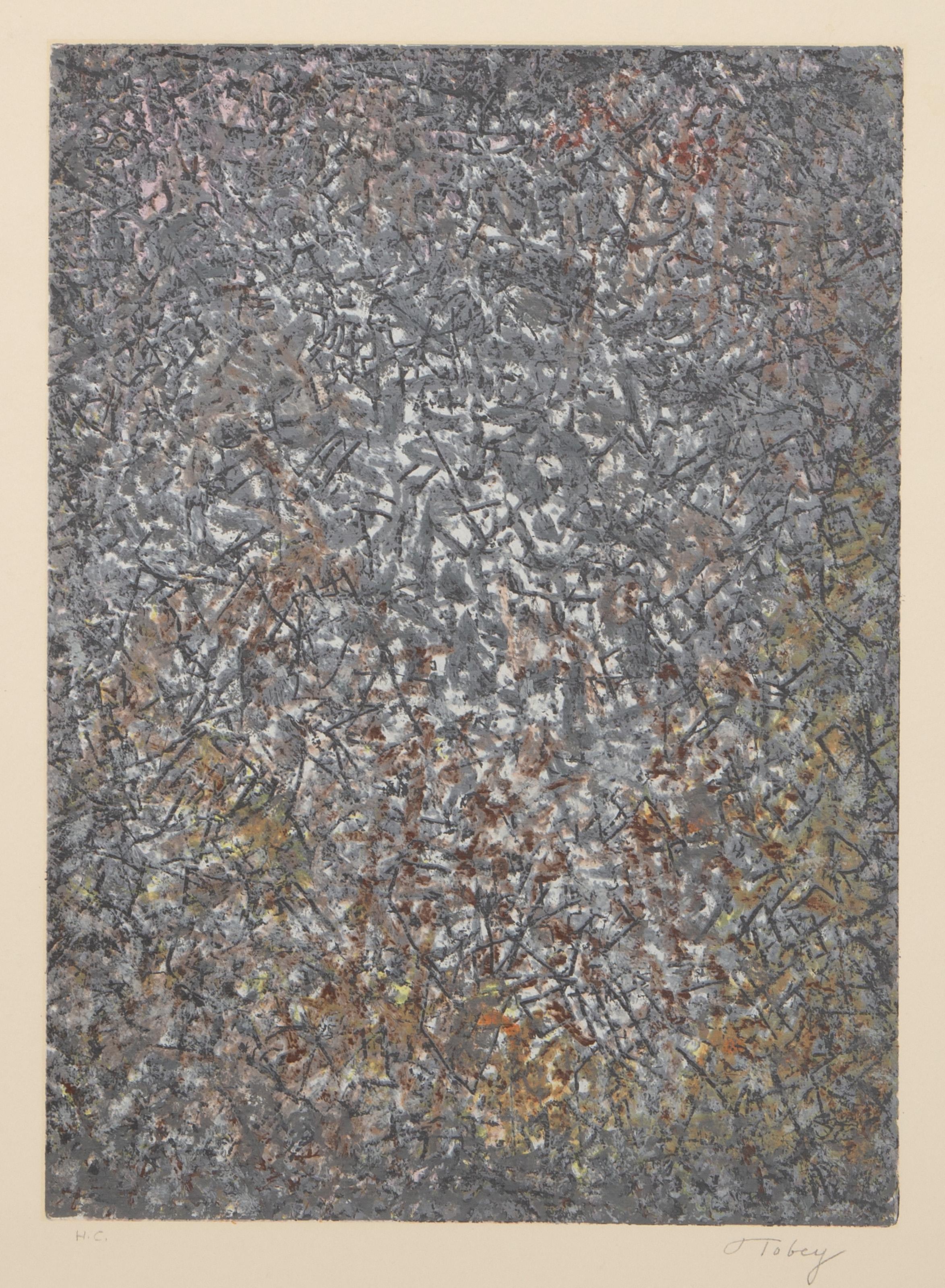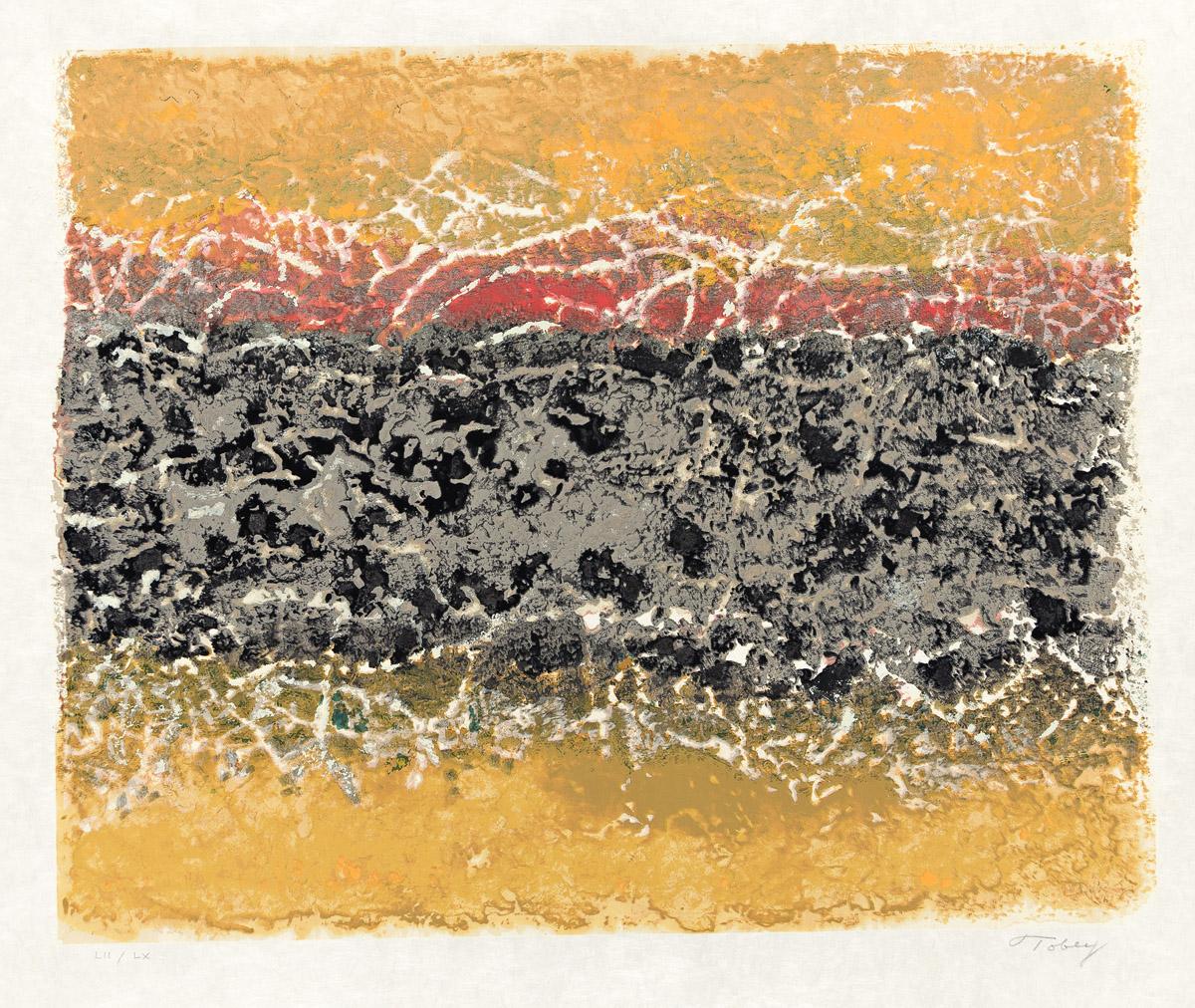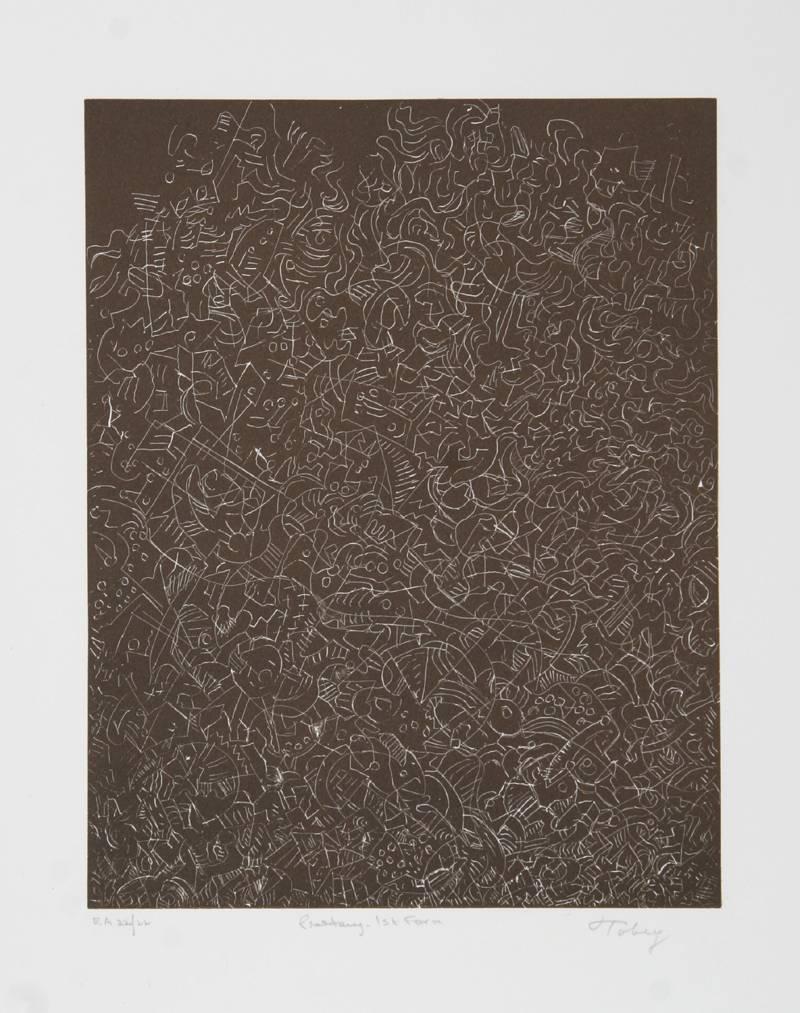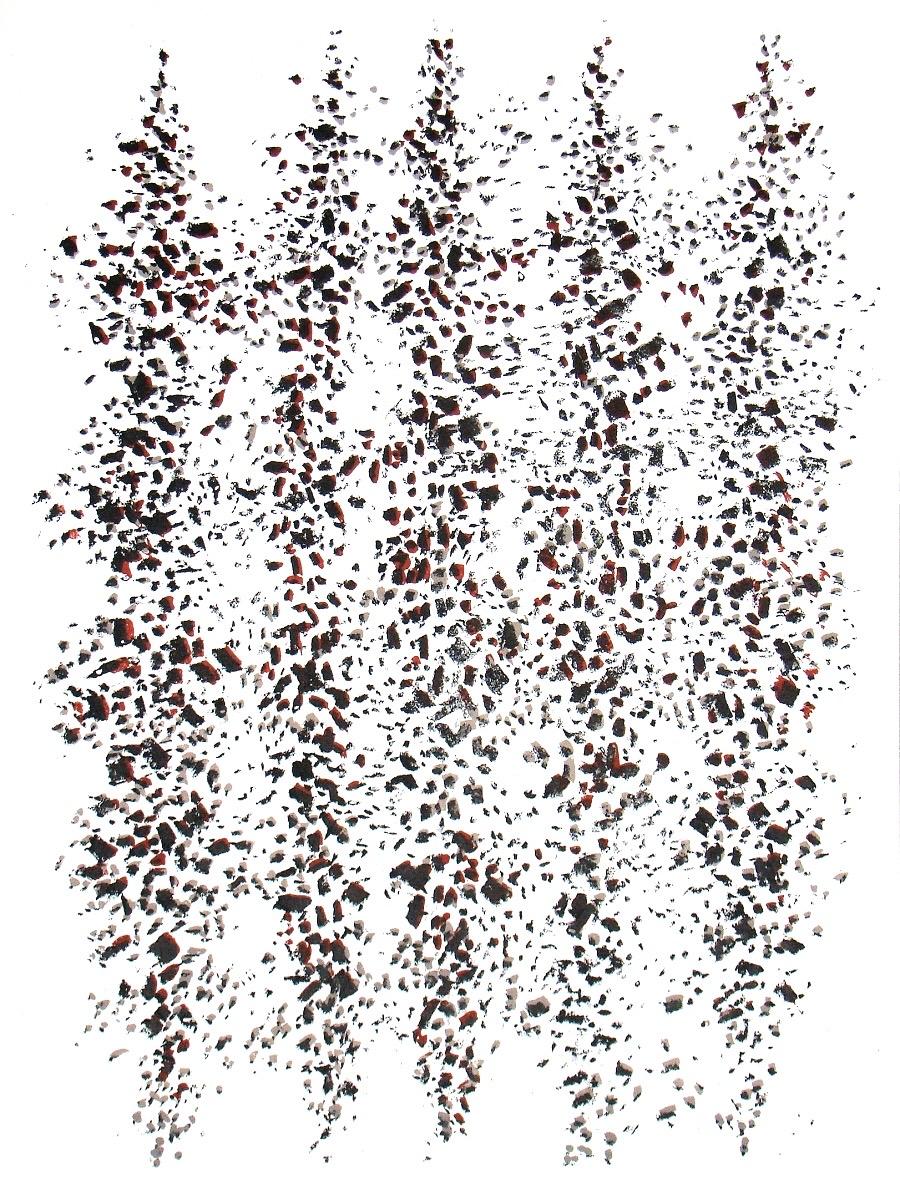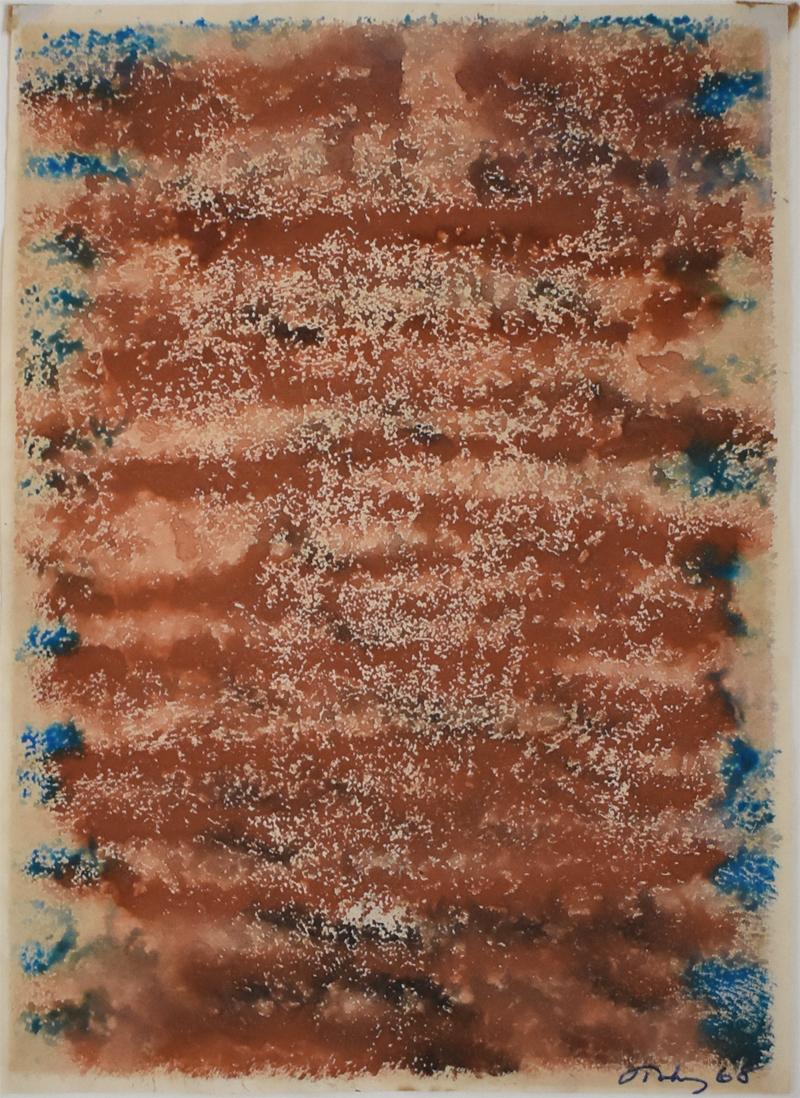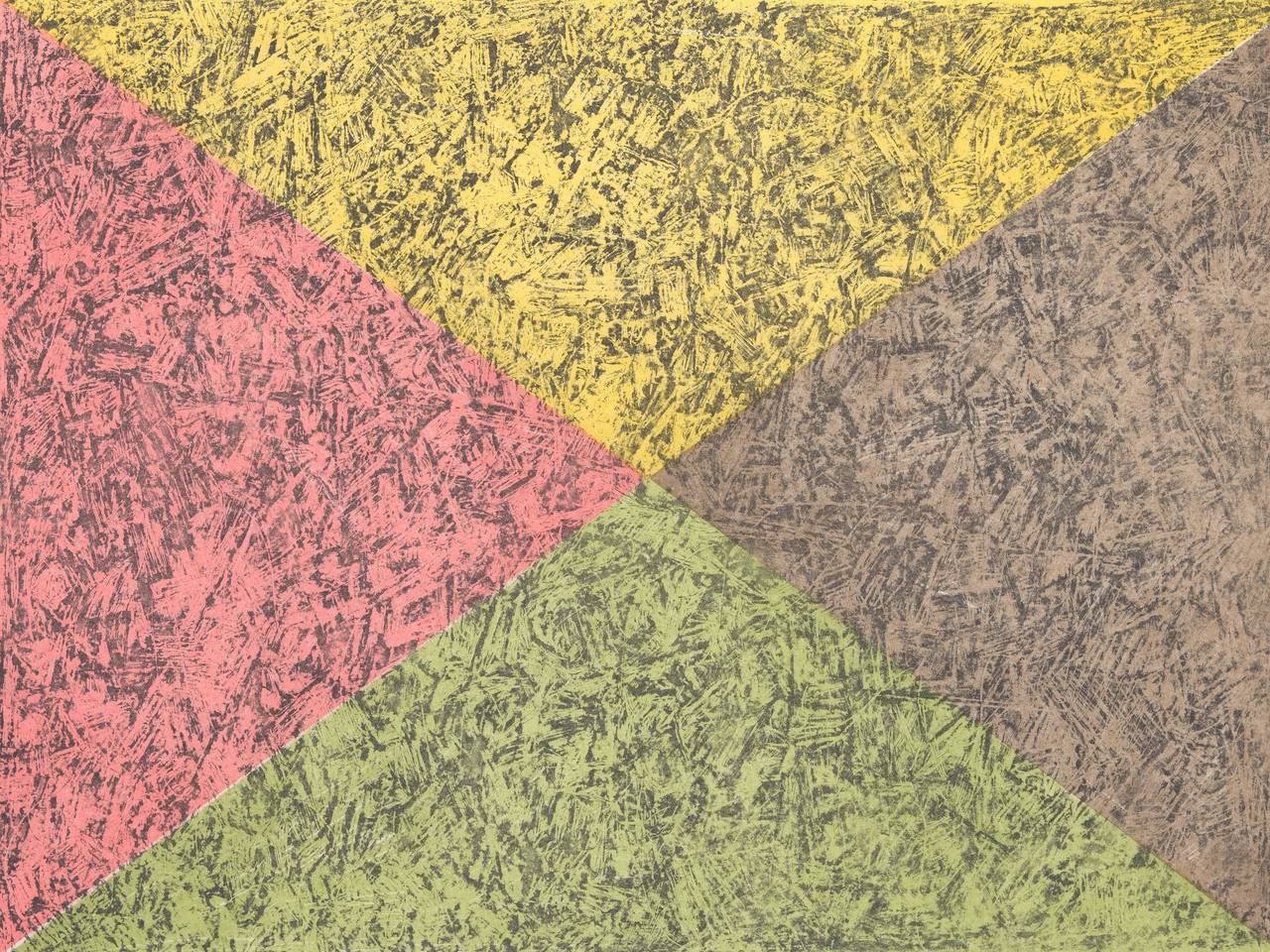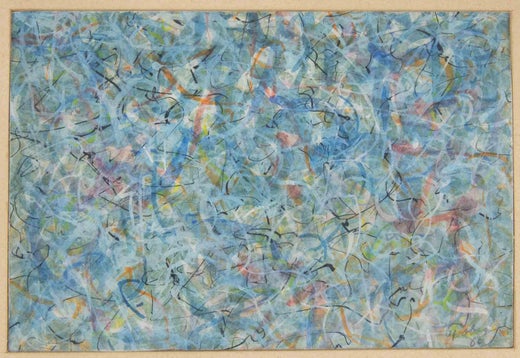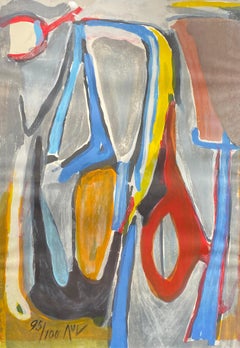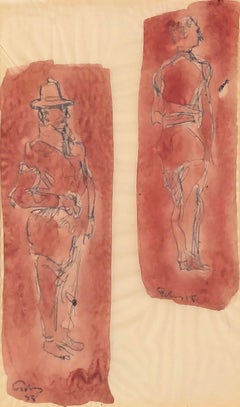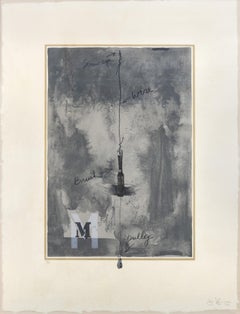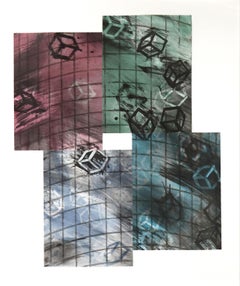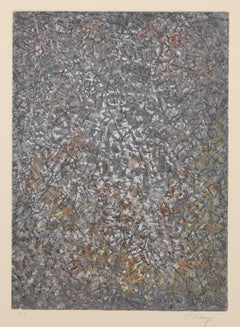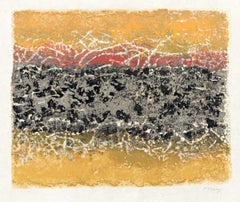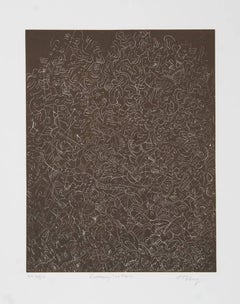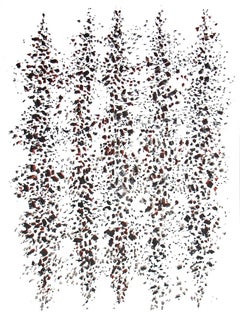Items Similar to Pensees Germinales
Want more images or videos?
Request additional images or videos from the seller
1 of 8
Mark TobeyPensees Germinales1973
1973
Price Upon Request
Price Upon Request
Price Upon Request
Price Upon Request
Price Upon Request
Price Upon Request
Price Upon Request
Price Upon Request
Price Upon Request
Price Upon Request
About the Item
Mark Tobey
"Pensees Germinales" 1973
Drypoint Engraving Printed in Brown and Blue by Willie Steinert, Karlsruhe, Germany, on Auvernge Paper Handmade by Richard de Bas
Signed Lower Right
From the Unnumbered Edition of 163
Image: 9 3/8 x 5 3/4 inches
Sheet: 21.5 x 15.5 inches
Framed: 32 x 26 inches
A painter of small abstract works with underlying religious themes as well as illustrator and muralist, Mark Tobey remains known primarily for his "white writing" paintings that give the impression of being expansive and much larger than they actually are. Tobey is sometimes categorized with the Abstract Expressionists, but in fact he was isolated spiritually and physically from its New York founders because of his immersion in Asian religion and major time spent in Europe and the Pacific Northwest.
Encountering the Bahai World faith in 1918 and later Zen Buddhism was pivotal to Mark Tobey's life and work in which he expressed themes of oneness and progression. As a result of his obvious commitment to spiritual aspects of painting, he has had a prestigious reputation as a modernist but is perhaps more appreciated in Europe and Asia than in America. Of modern American art, he said: "There have been 32 isms since the advent of cubism, . . . we have just been confused by the storm. . . we forget that there are today great men in the religious field with as much to offer. . .religion like science must be balanced to bring men to a state of equilibrium and that and that only will bring peace." (Herskovic 338)
Mark Tobey was born in Centerville, Wisconsin, and raised in the Midwest, lived in Indiana and Chicago where he briefly attended the Art Institute School. He worked as a commercial illustrator, and from 1911 to 1922, worked in New York City where he did fashion illustration and caricature for McCalls magazine and other publications. He also took private lessons from Kenneth Hayes Miller.
With a keen interest in philosophy and religion, especially beliefs of the Orient and Middle East, Mark Tobey's official affiliation with non-western religions began in 1918 when he converted to the Bahai faith and joined their World Church. Then between 1923 and 1931, he lived in several places including Seattle, Paris, New York City and Chicago. In Seattle, Tobey studied Chinese brush-work with Teng Kuei. From 1931 to 1938, he lived in England, where he was resident artist at the progressive school, Darlington Hall, near the town of Darlington. After that, until 1960, when he moved to Basel, Switzerland, Mark Tobey lived in Seattle where he was close to persons of Asian culture.
His painting subjects included portrait and genre scenes, but after 1935, he developed his signature technique of "white writing", described by scholar Matthew Baigell as a "tangle of thin, continuous linear strokes" linked to Oriental calligraphy and created from his desire not to be bound to realistic form. "For him, the white lines symbolized light as a unifying idea which flows through the compartmental units of life." He avoided focal points in his paintings and let the lines blur so that the overall canvas became a symbol "of the unity of forms and movements in the universe rather than an example of traditional organization hierarchies in which dominant elements brought lesser ones into subordination." His paintings reflect substance but not solidity, a sense of "cosmic wholeness, suggesting matter, space with nonspace and indivdual stroke with the totality of the pictorial field".
Sources include:
Matthew Baigell, Dictionary of American Art, pp. 354-355
Marika Herskovic, Editor, American Abstract Expressionists of the 1950s
- Creator:Mark Tobey (1890-1976, American)
- Creation Year:1973
- Dimensions:Height: 32 in (81.28 cm)Width: 26 in (66.04 cm)Depth: 1 in (2.54 cm)
- Medium:
- Movement & Style:
- Period:
- Condition:
- Gallery Location:Missouri, MO
- Reference Number:1stDibs: LU74735782522
Mark Tobey
Mark George Tobey (December 11, 1890 – April 24, 1976) was an American painter. His densely structured compositions, inspired by Asian calligraphy, resemble Abstract expressionism, although the motives for his compositions differ philosophically from most Abstract Expressionist painters.
About the Seller
5.0
Vetted Professional Seller
Every seller passes strict standards for authenticity and reliability
Established in 1970
1stDibs seller since 2017
156 sales on 1stDibs
Typical response time: Several days
- ShippingRetrieving quote...Shipping from: Missouri, MO
- Return Policy
More From This Seller
View AllAbstract (Edition 95/100)
By Bram Van Velde
Located in Missouri, MO
Abstract (Edition 95/100)
By Bram Van Velde (1895-1981)
Numbered Lower Left
Signed Lower Center
Unframed: 37" x 24"
Framed: 37.5" x 25.25"
Bram (Abraham Gerardus) van Velde was a Dutch painter known for an intensely colored and geometric semi-representational painting style related to Tachisme*, and Lyrical Abstraction*. He is often seen as member of the School of Paris* but his work resides somewhere between expressionism* and surrealism*, and evolved in the 1960s into an expressive abstract art. His paintings from the 1950s are similar to the contemporary work of Matisse, Picasso and the abstract expressionist Adolph Gottlieb. He was championed by a number of French-speaking writers, including Samuel Beckett and the poet André du...
Category
20th Century Abstract Abstract Prints
Materials
Lithograph
Price Upon Request
"Men at the Seattle Public Market" (Two Figures)
By Mark Tobey
Located in Missouri, MO
Mark Tobey
"Men at the Seattle Public Market" (Two Figures) 1958
Ink and Tempera on Silk
Signed and Dated Lower Left
*This is a rare and important work. See attached images with book...
Category
Mid-20th Century Modern Figurative Paintings
Materials
Silk, Ink, Tempera
Price Upon Request
M (ULAE 113)
By Jasper Johns
Located in Missouri, MO
M (ULAE 113), 1972
Jasper Johns (American, b. 1930)
Lithograph in Colors on Angoumois a la Main Paper
Hand Signed and Dated Lower Right
Numbered 56/67 Lower Left
38.5 x 29 inches
39....
Category
1970s Minimalist Abstract Prints
Materials
Paper, Lithograph
Four Quartets Third Quartet
By Mel Bochner
Located in Missouri, MO
Four Quartets Third Quartet, 1990
Mel Bochner (American, b. 1940)
Signed and Numbered Verso
Lithograph in Four Panels
42 x 34.5 inches
52.25 x 44 inches with frame
Mel Bochner, a po...
Category
1990s American Modern Abstract Prints
Materials
Lithograph
Lotus
By Angelo Savelli
Located in Missouri, MO
Angelo Savelli (1911-1995)
"Lotus" c. 1965
Collage and Lithograph
Signed, Titled and Numbered
Ed. 58/200
Framed Size: approx 26 x 21 inches
Image Size: approx. 23 x 19 inches
Octob...
Category
1960s Modern Abstract Prints
Materials
Lithograph
Abstract (Edition 24/75)
By Bram Van Velde
Located in Missouri, MO
Abstract (Edition 24/75)
By Bram van Velde (1895-1981)
Signed and Numbered Bottom Center
Without Frame: 37" x 24"
With Frame: 37.75" x 24.75"
Bram (Abraham Gerardus) van Velde was a Dutch painter known for an intensely colored and geometric semi-representational painting style related to Tachisme*, and Lyrical Abstraction*. He is often seen as member of the School of Paris* but his work resides somewhere between expressionism* and surrealism*, and evolved in the 1960s into an expressive abstract art. His paintings from the 1950s are similar to the contemporary work of Matisse, Picasso and the abstract expressionist Adolph Gottlieb. He was championed by a number of French-speaking writers, including Samuel Beckett and the poet André du...
Category
20th Century Abstract Abstract Prints
Materials
Lithograph
Price Upon Request
You May Also Like
Transformation, Abstract Expressionist Screenprint by Mark Tobey
By Mark Tobey
Located in Long Island City, NY
Mark Tobey, American (1890 - 1976) - Transformation, Year: circa 1970, Medium: Screenprint on Richard de Bas, signed, numbered and titled in pencil, Edition: AP, Image Size: 15.75 ...
Category
1970s Abstract Expressionist Abstract Prints
Materials
Screen
Sonata
By Mark Tobey
Located in New York, NY
A very good, richly-inked impression of this color screenprint on Japon nacré. The deluxe, Roman numeral edition of 60 on Japon nacré, aside from the regular edition of 100. Signed a...
Category
1970s Abstract Expressionist Abstract Prints
Materials
Color, Screen
$1,500
Psaltery, 1st Form, Abstract Etching by Mark Tobey
By Mark Tobey
Located in Long Island City, NY
Artist: Mark Tobey, American (1890 - 1976)
Title: Psaltery, 1st Form
Year: 1974
Medium: Etching on BFK Rives, signed and numbered in pencil
Edition: EA 22
Paper Size: 25.5 x 19.5 in....
Category
1970s Abstract Expressionist Abstract Prints
Materials
Etching
Sans titre, Société internationale d'art XXe siècle
By Mark Tobey
Located in Southampton, NY
Lithograph on vélin paper. Paper Size: 12.4 x 9.65 inches. Inscription: Unsigned and unnumbered, as issued. Notes: From the album, XXe siècle, Nouvelle série N° 5 (double) Juin 1955, Cahiers d'Art publiés sous la direction de Gualtieri di San Lazzaro, 1955. Published by Société Internationale d'Art XXe siècle, Paris, under the direction of Gualtieri di San Lazzaro, éditeur, Paris; printed by Mourlot Frères, Paris, 1955. Additional notes: Excerpted from the academic article, “Promoting Original Prints, The Role of Gualtieri di San Lazzaro and XXe Siècle” by Valerie Holman, published in Print Quarterly, XXXIII, 2016, 2, Until recently very little has been written on the Italian author and art publisher Gualtieri di San Lazzaro (1904-75), yet for 50 years he chronicled the life and work of contemporary artists, produced monographs of exceptional quality, and disseminated original prints by modern painters and sculptors through his best-known periodical, XXe Siècle. Although still a relatively unfamiliar figure in the United Kingdom, San Lazzaro is one of the half-dozen great art publishers of the mid-twentieth century who, together with his exemplar, Ambroise Vollard (1866-1939), and those of his own generation, Christian Zervos (1889-1970), Tériade (1889-1983) and Albert Skira (1904-73), chose to base himself in Paris, seeing it throughout his life as the centre of the art world….XXe Siècle, an illustrated periodical, was launched in 1938 and printed in editions of approximately 2,000, each issue containing both photographs and four-colour separation reproductions across a wide spectrum of visual imagery ranging from masterpieces of Western painting to popular prints from the Far East. Its large format, lively design, and close integration of text and image, were immediately striking, but its most innovative feature, introduced at the suggestion of Hans Arp (1886-1966), was the inclusion of original prints by contemporary artists in every issue. With obvious appeal for collectors, XXe Siècle was also designed to introduce a wider, international public to contemporary painting and sculpture through good quality colour reproductions and the immediacy of original prints. Comparable in price to Cahiers d'Art, early issues of XXe Siècle sold out rapidly. While San Lazzaro's own aesthetic preferences tended towards lyric abstraction, he made clear that XXe Siècle was non-partisan [publication ceased during World War II]….in 1951, San Lazzaro relaunched XXe Siècle with thematic issues that were materials based, or centred on a topic of current interest in the visual arts, particularly in Europe: concepts of space, matter, monochrome, mark-making and the sign.' A defining feature of the new series was Italy's artistic dialogue with France for, while San Laz-zaro had originally concentrated on Paris-based painters and sculptors, his aim was to create an international network, to make known the work of French artists in Italy and Italian artists in France, and subsequently extend this bilateral axis to the English-speak-ing world. The artists represented in No. I by an original print were all best known as sculptors: Arp, Laurens, Henry Moore (1898-186) and Marino Marini, San Lazzaro not only sought to show readers the full range of an artist's work, but to encourage the production of prints, a stimulus much appreciated, for example, by Magnelli…. Suffering from failing health, in 1968 San Lazzaro lost overall control of XXe Siècle to Léon Amiel, a printer-publisher who had provided financial backing and helped with distribution in America." Thematic issues now ceased and were replaced by a 'panorama' of the year, but San Lazzaro was still active as a publisher of books and albums of prints….Shortly after his death, San Lazzaro himself was the subject of two exhibitions: 'Omaggio a XXe Siècle' in Milan in December 1974 centred on graphic work by those artists closest to him late in life, while 'San Laz-zaro et ses Amis' at the Musée d'Art Moderne de la Ville de Paris in 1975 featured work by all those whose work he had promoted for more than 50 years: Arp, Calder (1898-1976), Capogrossi, Chagall, Sonia Delau-nay, Dubuffet, Estève, Lucio Fontana (1899-1968), Gili-oli (1911-77), Magnelli, Marini, Miró, Moore and Poliakoff. This exhibition was seen by one of his closest colleagues as an indirect portrait of San Lazzaro, a complex man whose modesty and reserve masked his unremitting drive to extend international appreciation of contemporary art, and to bring the reading public closer to its making through the medium of print.
MARK TOBEY (1890-1976) was an American painter. His densely structured compositions, inspired by Asian calligraphy, resemble Abstract expressionism, although the motives for his compositions differ philosophically from most Abstract Expressionist painters. His work was widely recognized throughout the United States and Europe and came in the wake of Picasso and Braque. Along with Guy Anderson...
Category
1950s Modern Abstract Prints
Materials
Lithograph
$956 Sale Price
20% Off
Free Shipping
Composition - American painting, Post War Art
By Mark Tobey
Located in London, GB
MARK TOBEY 1890-1976
Centerville 1890 - 1976 Basel (American)
Title: Composition, 1968
Technique: Original Tempera Painting on Paper
Paper size: 15.5 x 11.5 cm. / 6.1 x 4.5 in.
...
Category
1960s Abstract Paintings
Materials
Tempera
The Season's Encounter
By Mark Tobey
Located in Fairlawn, OH
The Season's Encounter
Signed, dated and numbered in the lower margin
Edition: 20 (16/20)
Signed, dated and numbered in the lower margin
Condition: Mint, flawless
Image: 17 3/4 x 13 ...
Category
1960s Abstract Abstract Prints
Materials
Lithograph
